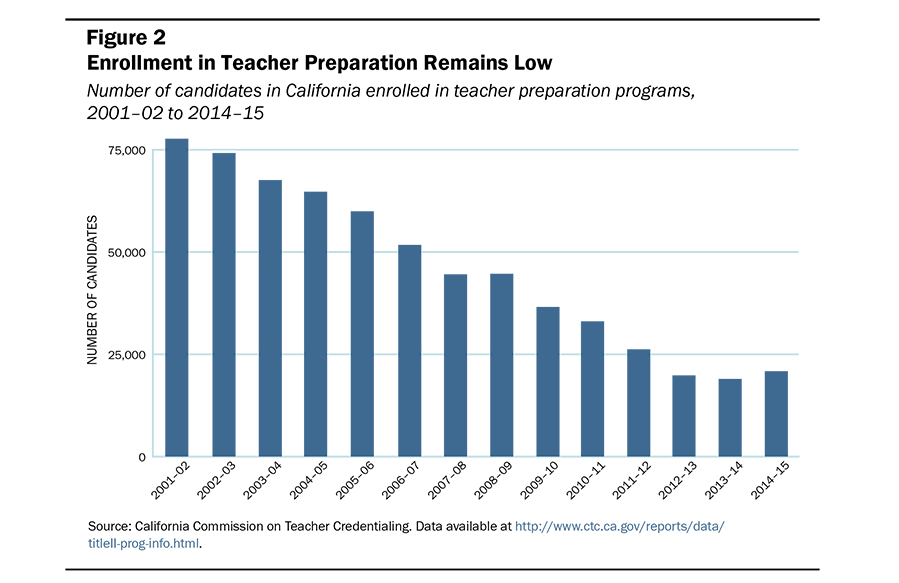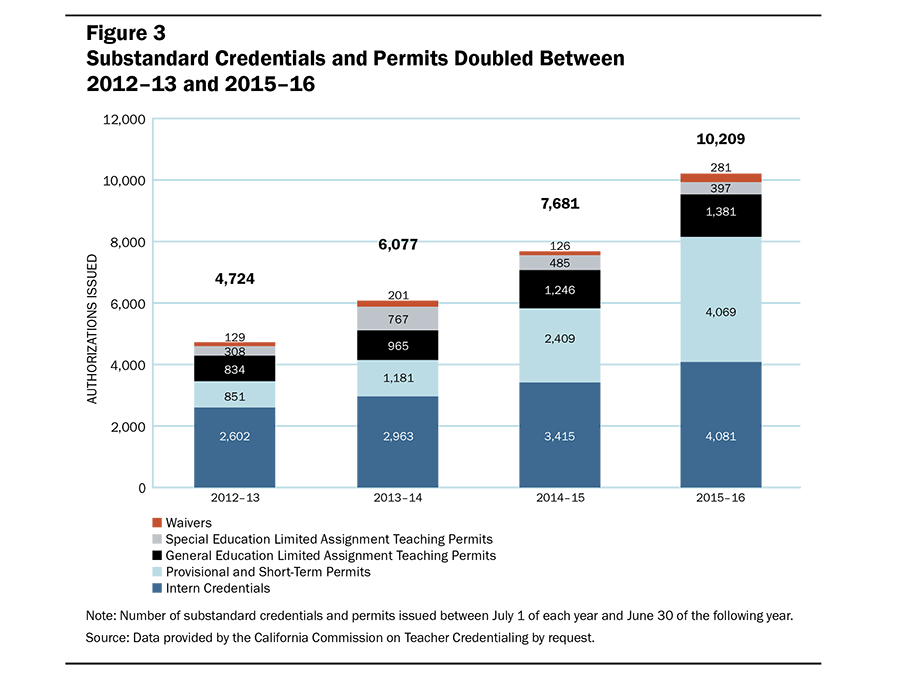California Teacher Workforce Trends Signal Worsening Shortages

In the past year, overall teacher workforce trends in California have worsened, with especially severe consequences in special education, math, and science, and significant threats in bilingual education. Survey data suggest that, in addition to canceling courses and increasing class sizes, districts are responding to shortages by hiring underprepared teachers (teachers who have not yet completed the subject matter and teacher preparation requirements for a full credential); assigning some teachers out of their fields of preparation; and hiring substitutes, who need only pass a basic skills test.Podolsky, A., & Sutcher, L. (2016). California teacher shortages: A persistent problem. Palo Alto, CA: Learning Policy Institute and California School Boards Association. The demographics of the sample of over 200 California districts are generally representative of the average district demographics in the state. Relying on underprepared, out-of-field, and substitute teachers is a cause for concern. Evidence shows that these teachers typically depress student achievement and have higher attrition rates.Ranjana, D. (2009). Investigating the impact of substitute teachers on student achievement: A review of the literature. Albuquerque, NM: Albuquerque Public Schools (accessed 12/5/16); Miller, R. T., Murnane, R. J., & Willett, J. B. (2008). Do teacher absences impact student achievement? Longitudinal evidence from one urban school district. Educational Evaluation and Policy Analysis, 30(2), 181–200; Boyd, D., Grossman, P., Lankford, H., Loeb, S., & Wyckoff, J. (2006). How changes in entry requirements alter the teacher workforce and affect student achievement. Education Finance and Policy, 1(2), 176–216; Darling-Hammond, L., Holtzman, D. J., Gatlin, S. J., & Heilig, J. V. (2005). Does teacher preparation matter? Evidence about teacher certification, Teach for America, and teacher effectiveness. Education Policy Analysis Archives, 13(42); Clotfelter, C. T., Ladd, H. F., & Vigdor, J. L. (2007). Teacher credentials and student achievement: Longitudinal analysis with student fixed effects. Economics of Education Review, 26(6), 673–682. The high attrition rates of underprepared teachers create continuous demand for new teachers and exacerbate shortages.Ingersoll, R., Merrill, L., & May, H. (2014). What are the effects of teacher education and preparation on beginning teacher attrition? Philadelphia, PA: Consortium for Policy Research in Education; Podolsky, A., Kini, T., Bishop, J., & Darling-Hammond, L. (2016). Solving the teacher shortage: How to attract and retain excellent educators. Palo Alto, CA: Learning Policy Institute; Ingersoll, R. (2001). Teacher turnover and teacher shortages: An organizational analysis. American Educational Research Journal, 38(3), 499–534. Moreover, schools serving the most vulnerable students, including students in high-poverty, high-minority, and high-English Learner schools, disproportionately turn to underprepared teachers to meet their hiring needs.Podolsky, A., & Sutcher, L. (2016). California teacher shortages: A persistent problem. Palo Alto, CA: Learning Policy Institute and California School Boards Association; California state plan to ensure equitable access to excellent educators. (2016). Sacramento: California Department of Education (accessed 12/21/16); Ingersoll, R. (2001). Teacher turnover and teacher shortages: An organizational analysis. American Educational Research Journal, 38(3), 499–534.
Current California Teacher Workforce Trends
- Stagnant teacher supply is insufficient to meet growing teacher demand. New California credentials have remained constant at 11,500 since 2013–14, while the number of projected new hires has exceeded 20,000 (see Figure 1).

- Enrollment in teacher preparation remains near historic lows. Despite a 10% increase in teacher preparation enrollments between 2013–14 and 2014–15, the number of teaching candidates enrolled in 2014–15 was just one-quarter of the number enrolled in 2001–02 (see Figure 2).
- There have been significant increases in substandard credentials and permits. In 2015–16, California issued more than 10,000 intern credentials, permits, and waivers, more than double the number issued in 2012–13 (see Figure 3). These authorizations to teach were granted to those who had not completed—or sometimes not even started—preparation for teaching. The greatest growth has been in emergency-style permits known as Provisional Intern Permits (PIPs) and Short-Term Staff Permits (STSPs).

- In 2015–16, California had more than 4,000 teachers on PIPs and STSPs, nearly five times as many as in 2012–13. About 1,700 PIPs and STSPs were issued in special education, and more than 450 in math and science.
- More special education teachers are entering the classroom on substandard credentials or permits than are entering with full teaching credentials. Just 36% of new special education teachers in 2015–16 had a preliminary credential. The remaining 64% of new special education teachers—more than 4,000 teachers—entered the field as interns or with permits or waivers. No other major teaching field issues most of its credentials to underprepared candidates.

- The pipeline of prepared math and science teachers continues to shrink. Between 2012 and 2016, the proportion of math and science teachers entering the field on substandard credentials or permits doubled, going from 20% to nearly 40% of the total, while the number of such teachers entering with full credentials dropped from 3,200 to only 2,200 over that time frame.
- California may be unprepared to meet the expected increase in demand for bilingual education teachers as schools develop and expand bilingual programs under Proposition 58. At 700 new bilingual teachers in 2015–16, California authorizes fewer than half the number of new bilingual teachers it did when bilingual education hiring was at its peak in the mid–1990s.
- Shortages disproportionately impact low-income and minority students. Teachers hired on emergency-style credentials are twice as likely to teach in high-poverty schools than in low-poverty schools and are three times more likely to teach in high-minority schools than in low-minority schools.
In the past year, California’s teacher shortage has worsened as teacher demand grows and teacher supply stagnates. As a result, districts are having to hire a growing number of teachers on substandard permits and credentials, which are increasing more quickly than are preliminary credentials. Fortunately, recent California legislation demonstrates a concern for addressing the worsening teacher shortages through funding recruitment efforts, 4-year integrated bachelor degree and teaching credential programs, and up to 5 years of postsecondary and teacher preparation training for classified staff.2016–17 state funded grant programs: Announcement of awards. (2016). Sacramento, CA: Commission on Teacher Credentialing (accessed 12/12/16).
However, benefits from the most recent budget investments will not be apparent for 5 years or more, as funded programs still need to be designed and launched before candidates spend 4–5 years participating in them. In the meantime, students will suffer the consequences of ongoing shortages. California’s goals for high-quality education will be undermined if the state continues to supplement an inadequate teacher supply with underprepared teachers who leave at high rates (two to three times greater than prepared teachers), thereby provoking greater churn in high-need schools and depressing student achievement.Ingersoll, R., Merrill, L., & May, H. (2014). What are the effects of teacher education and preparation on beginning teacher attrition? Philadelphia, PA: Consortium for Policy Research in Education, CPRE Report (#RR–82).
To address the shortfalls, more immediate solutions would be needed. To strengthen the teacher supply pipeline, California could:
- Offer service scholarships or loan forgiveness programs that cover the cost of tuition and living expenses to teacher candidates who commit to teach in high-need fields and locations. Service scholarship and loan forgiveness programs have a track record of recruiting and retaining qualified teachers in the places where they are most needed.
- Boost the supply of teachers entering shortage fields and locations through high-retention teacher preparation programs completed in one year at the postbaccalaureate level, such as teacher residency models. These teachers could immediately fill vacancies in shortage fields with the training and incentives to have successful and lasting careers.
- Eliminate barriers to re-entry for retired teachers in shortage fields, or postpone their exit. Retired teachers are an untapped resource that can help meet immediate hiring needs. In the short term, the state could remove caps on earnings that would allow districts to hire retirees to return to schools as teachers and mentors. If employees pay into the retirement system, this would be revenue neutral. The state could also use a Deferred Retirement Option Program to keep experienced teachers in shortage fields.
California Teacher Workforce Trends Signal Worsening Shortages is licensed under a Creative Commons Attribution-NonCommercial 4.0 International License.
This research was supported by grants from the Stuart Foundation and the S. D. Bechtel, Jr. Foundation. Core operating support for the Learning Policy Institute is provided by the Sandler Foundation.
